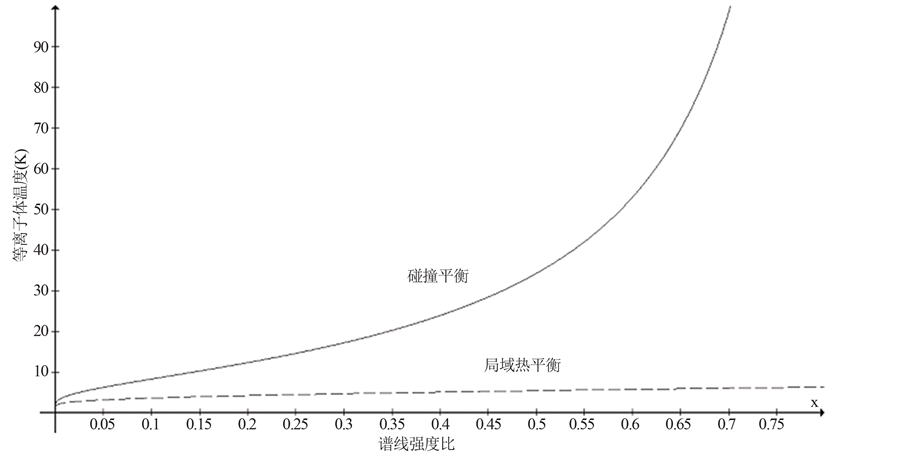1. 引言
从宇宙辐射线的特性研究等离子体的温度、电子数密度和化学成份是一个重要研究课题,也是等离子体诊断的基本理论。Spitzer空间望远观测仪记录了11个星际空间10~37 μm的多条远红外辐射线,为星际空间等离子体特性研究提供了重要数据。其中,H II空间的S III离子辐射线是比较重要的辐射线,得到了广泛研究[1] -[3] 。为了进行较为准确的等离子体诊断,必须考虑影响谱线强度的一些主要物理过程,我们曾经以太阳等离子体中若干离子为例,分析了谱线不透明度对谱线强度的影响,得到了一些重要结论[4] -[6] 。
在以往的等离子体诊断中,常假定等离子体处于局域热平衡条件,因此利用玻尔兹曼分布分析不同能级的粒子数的分布情况[7] [8] 。然而,在实际等离子体中,由于离子和自由电子的热运动,离子和自由电子相互碰撞,导致低能级离子跃迁到高能级,我们成为碰撞激发过程;同样,高能级离子也可能和自由电子相互碰撞,跃迁回低能级,我们成为碰撞退激发,退激发过程不辐射光子,是自由电子携带走了能量,此过程成为无辐射跃迁过程。
因此本文利用电子碰撞模型,讨论碰撞平衡条件,并考虑在碰撞平衡条件下,等离子体温度的诊断原理和方法。S III离子辐射线由三条非常接近的远红外辐射线组成,分别来自于3s23p22PJ的电子跃迁,其中J的取值为0,1,2,1-0跃迁对应波长 ,2-1跃迁对应波长
,2-1跃迁对应波长 ,2-0跃迁对应波长
,2-0跃迁对应波长 ,属于典型的三能级结构,因此本文主要讨论三能级系统的等离子体温度诊断原理。
,属于典型的三能级结构,因此本文主要讨论三能级系统的等离子体温度诊断原理。
2. 碰撞平衡条件
考虑一个离子具有低能级1和高能级2的离子,当一个动能大于能量差 的电子和离子碰撞时,可以把离子从低能级1激发到高能级2。同理,具有任意能量的电子和离子碰撞可以把离子从高能级2退激发到低能级1。如前所述,退激发过程没有辐射光子产生,是碰撞电子带碰撞电子带走了能量。
的电子和离子碰撞时,可以把离子从低能级1激发到高能级2。同理,具有任意能量的电子和离子碰撞可以把离子从高能级2退激发到低能级1。如前所述,退激发过程没有辐射光子产生,是碰撞电子带碰撞电子带走了能量。
通常利用一个无量纲的物理量-碰撞强度 来描述这种跃迁。碰撞强度
来描述这种跃迁。碰撞强度 和碰撞截面
和碰撞截面 的关系为[9]
的关系为[9]
 (1)
(1)
其中 为普朗克常数,
为普朗克常数, 为电子质量同,
为电子质量同, 为碰撞电子的动能,
为碰撞电子的动能, 为统计权重。
为统计权重。
碰撞退激发率可以写为
 (2)
(2)
其中速度 ,
, 为麦克斯韦分布函数。利用麦克斯韦分布函数的表达式,我们可以得到所谓率退激发率系数
为麦克斯韦分布函数。利用麦克斯韦分布函数的表达式,我们可以得到所谓率退激发率系数 为
为
 (3)
(3)
通常利用麦克斯韦平均碰撞强度来描述退激发过程
 (4)
(4)
根据(3)式和(4)式,我们可以把退激发率系数写为
 (5)
(5)
其中
 (6)
(6)
利用相似方法,我们可以得到激发率系数
 (7)
(7)
3. 三能级离子的温度诊断原理
考虑一个如图1所示的三能级离子,考虑到离子和自由电子的上述碰撞过程,我们可以写出第三个能级的速率方程
 (8)
(8)
其中我们利用 表示碰撞跃迁。利用同样的方法,我们可以写出第二个能级的速率方程
表示碰撞跃迁。利用同样的方法,我们可以写出第二个能级的速率方程
 (9)
(9)
从(8)式和(9)式,我们可以得到

Figure 1. Collision and transition diagram for ion with three levels
图1. 三能级离子的碰撞和跃迁图
 (10)
(10)
解此方程可以得到
 (11)
(11)
实际上这些跃迁为禁戒跃迁,因此跃迁系数 远大于自发辐射系数
远大于自发辐射系数 ,因此我们可以把(11)式写为
,因此我们可以把(11)式写为
 (12)
(12)
一般情况下 ,我们可以把上式写为
,我们可以把上式写为
 (13)
(13)
其中 通常称为分支比。利用谱线强度表达式,我们有
通常称为分支比。利用谱线强度表达式,我们有
 (14)
(14)
注意到 和
和 ,我们可以得到
,我们可以得到
 (15)
(15)
从(15)式可以看到,如果已知跃迁相关参数,根据探测到的谱线的强度比可以对等离子体温度进行诊断,这就是根据谱线强度比诊断等离子体温度的基本原理。
4. S III离子的温度诊断模拟
这里我们以Spitzer空间望远观测仪记录的H II空间的S III离子为例,其三条精细结构远红外辐射线的辐射特性如表1所示。
对应能级能量差为 。由于碰撞强度的比值为温度的慢变函数,因此可以假定在诊断温度范围内,碰撞强度比值保持不变。根据参考文献可以发现在
。由于碰撞强度的比值为温度的慢变函数,因此可以假定在诊断温度范围内,碰撞强度比值保持不变。根据参考文献可以发现在 时,对应碰撞强度分别为
时,对应碰撞强度分别为 和
和 [10] 。
[10] 。
如果定义 为3-2和2-1跃迁的强度比,把这些参量带入(15)式,我们可以得到在碰撞平衡条件下温度为
为3-2和2-1跃迁的强度比,把这些参量带入(15)式,我们可以得到在碰撞平衡条件下温度为
 (16)
(16)

Table 1. Radiation characteristics of S III emission lines
表1. S III辐射线的辐射特性
在局域热平衡条件下,两条谱线的强度比表示为
 (17)
(17)
从(17)式我们可以得到在局域热平衡条件下的温度可以表示为
 (18)
(18)
当观测到的强度比 从0到0.8变化时,我们模拟的碰撞平衡和局域热平衡条件下的等离子体温度变化如图2所示。从图2我们可以发现:
从0到0.8变化时,我们模拟的碰撞平衡和局域热平衡条件下的等离子体温度变化如图2所示。从图2我们可以发现:
1) 在碰撞平衡条件下,在 从0到0.7变化时,等离子体温度约为几十K,且随比值的增大而缓慢增大,在
从0到0.7变化时,等离子体温度约为几十K,且随比值的增大而缓慢增大,在 从0.7到0.8变化时,等离子体温度随比值的增大而缓急剧增大;
从0.7到0.8变化时,等离子体温度随比值的增大而缓急剧增大;
2) 在局域热平衡条件下,等离子体温度不足10 K,且随谱线强度比的增长非常缓慢的增大。
5. 结论
在本文中,利用离子和自由电子之间的碰撞激发和退激发,我们分析了碰撞平衡条件。并分析了三能级离子的等离子体温度诊断原理。最后以H II空间的S III离子为例,在碰撞平衡和局域热平衡条件下,分析了等离子体温度诊断的原理和差别。通过讨论,可以得到以下主要结论:
1) 考虑到离子与自由电子的碰撞激发和退激发,是准确等离子体温度诊断的重要方法,比局域热平衡更加接近实际的粒子数分布;
2) 在碰撞平衡条件下,在S III离子谱线强度比 从0到0.7变化时,等离子体温度约为几十K,且随比值的增大而缓慢增大,在
从0到0.7变化时,等离子体温度约为几十K,且随比值的增大而缓慢增大,在 从0.7到0.8变化时,等离子体温度随比值的增大而缓急剧增大;
从0.7到0.8变化时,等离子体温度随比值的增大而缓急剧增大;
在局域热平衡条件下,在S III离子谱线强度比 从0到0.8变化时等离子体温度不足10 K,且随谱线强度比的增长非常缓慢的增大。
从0到0.8变化时等离子体温度不足10 K,且随谱线强度比的增长非常缓慢的增大。

Figure 2. Variation relation of plasma temperature and spectral intensity ratio under the condition of collision equilibrium and local thermal equilibrium
图2. 碰撞平衡和局域热平衡条件下等离子体温度和谱线强度比的变化关系
基金项目
国家自然科学基金(No.11205047)资助项目。